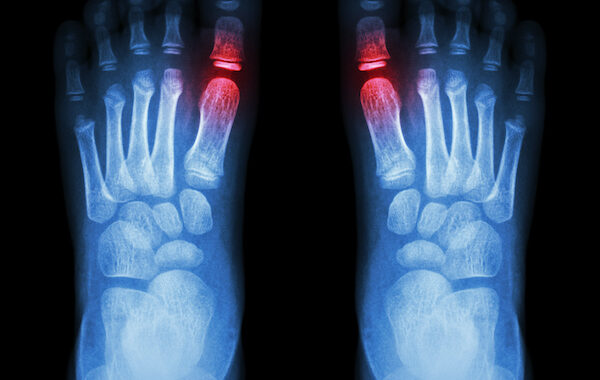Big toe arthritis, also known as hallux rigidus, is a form of degenerative arthritis or osteoarthritis that occurs when the cartilage in the hallux (big toe) joint wears away or is injured. The condition can induce incapacitating pain and make walking and standing difficult.
Big toe arthritis is a progressive disorder that can worsen over time. For some people, the pain does not get any worse than it was when it started. However, for others, the pain and discomfort only increase over time. If the condition is left untreated, the bones in the feet may eventually grow out of control and fuse together on their own, resulting in a complete loss of function.
Causes
Like osteoarthritis anywhere else in the body, big toe arthritis usually develops spontaneously and for no apparent reason. Your genetics may have a role in this. Other factors include:
- Overuse of the metatarsophalangeal (MTP) joints at the base of the big toe
- Foot injuries like joint sprains or stubbed toe
- Chronic inflammatory disorders like rheumatoid arthritis or gout (gouty arthritis)
Symptoms
If you have big toe arthritis, you may have pain and stiffness all the time or when moving the toe in any position. This could be a sign of severe arthritis. Some patients, however, may only experience pain when they bend their big toe too far or too forcefully. Pain in and around a single joint that occurs only when the joint is moved beyond a certain limit may suggest less severe arthritis or a region of localized arthritis.
Non-Surgical Treatment Options
Before considering surgery for big toe arthritis, you can try a variety of non-surgical treatments to reduce pain and restore function in your toe. These include:
- Wear shoes with lots of room for your toes. “Rocker” style shoes are an option. These shoes have a thick sole and rounded heel, which reduces the need to bend your toes completely back as you lift your foot when walking. This can help relieve strain on your big toe joint and alleviate the painful symptoms of big toe arthritis.
- Avoiding high heels can also reduce pain, as high heels stress the head of the first metatarsal (the bone in the foot just behind the big toe).
- Use custom orthotics designed to thicken the sole of a shoe and relieve pressure on the big toe when walking.
- Avoid physical activities that put extra strain on your toe joint.
- A combination of pain relievers such as paracetamol and non-steroidal anti-inflammatory drugs (NSAIDs) such as ibuprofen helps alleviate pain and swelling. All medications come with health risks, so make sure you consult with your doctor before using them.
- Try “contrast bath therapy” that alternates between cold and hot water to reduce swelling in your big toes. Immerse your foot in hot water for about a minute, followed by immediate immersion in cold water for another minute.
- Cortisone shots (also called corticosteroids or steroid shots) can also help relieve pain.
Surgical Treatment Options
When it comes to treating pain and stiffness associated with big toe arthritis, conservative methods are not always enough. If your pain is interfering with your everyday life, you may need to consider surgery. The following surgical procedures are commonly used to treat big toe arthritis:
1. Cheilectomy
A dorsal cheilectomy is the least invasive surgical treatment for big toe arthritis. This surgical procedure involves cutting away conspicuous bony masses or bone spurs (osteophytes) — particularly near the big toe — joint with a saw or a burr. Dorsal cheilectomy can enhance the range of motion at the big toe joint and decrease pain caused by bony impingement. The procedure can be performed through a small incision or using keyhole techniques.
2. Moberg Osteotomy
Moberg osteotomy is a surgical procedure that reorients the proximal phalanx (the toe bone closest to the leg). The objective of this orthopedic surgery is to alter the arc of motion so that the toe points up — but it does not affect the overall size of the arc of motion. This surgery involves extracting a small wedge bone and fixing it with a small metal screw. Moberg osteotomy is usually performed in conjunction with dorsal cheilectomy to provide upward movement of the toe and pain relief from unnatural movement.
3. Joint Fusion
Joint fusion (also known as arthrodesis) can effectively treat big toe arthritis. This surgical procedure involves implanting metal screws or rods to fuse the damaged bones in and around the big toe joint back together. The fused joint does not move at all, which is quite effective at relieving pain. However, the pain relief does come at the expense of movement. Patients who have a joint fusion will be unable to wear heels or find it challenging to run longer distances. Normal daily activities, such as walking, will stay unaffected.
Consult your podiatrist if you are experiencing pain in your big toe joint. The earlier a diagnosis for big toe arthritis is made, the more successful its treatment can be. Treatment usually consists of getting shoes that fit right, using pain killers, and resting the joint. However, surgery may be needed if your life continues to be impacted by the debilitating pain that comes with big toe arthritis. As we just learned, there are various surgical options. Your podiatrist will go over them with you and help you determine which one is most suitable for you.
Shop at FootDocStore
Visit the FootDocStore.com online store to find a wide selection of foot pain relief and comfort solutions. Also, be sure to check out our blog to learn more about how to keep your feet and ankles healthy and happy.

